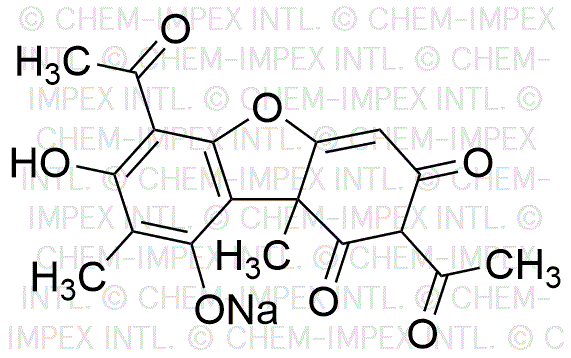(+)-Sodium usnic acid, extracted from Usnea, is widely utilized in research focused on
- Antimicrobial Applications: This compound is known for its antibacterial and antifungal properties, making it valuable in developing natural preservatives for food and cosmetics.
- Pharmaceutical Development: Researchers explore its potential in formulating new medications, particularly for skin infections and other ailments due to its bioactive nature.
- Cosmetic Formulations: Its antioxidant properties are harnessed in skincare products, helping to protect skin from oxidative stress and improve overall skin health.
- Environmental Research: The compound is studied for its role in bioremediation, where it may help in detoxifying polluted environments, showcasing its ecological benefits.
- Natural Dye Production: Usnic acid can be used in creating natural dyes for textiles, appealing to industries focused on sustainable and eco-friendly practices.
General Information
Properties
Safety and Regulations
Applications
(+)-Sodium usnic acid, extracted from Usnea, is widely utilized in research focused on
- Antimicrobial Applications: This compound is known for its antibacterial and antifungal properties, making it valuable in developing natural preservatives for food and cosmetics.
- Pharmaceutical Development: Researchers explore its potential in formulating new medications, particularly for skin infections and other ailments due to its bioactive nature.
- Cosmetic Formulations: Its antioxidant properties are harnessed in skincare products, helping to protect skin from oxidative stress and improve overall skin health.
- Environmental Research: The compound is studied for its role in bioremediation, where it may help in detoxifying polluted environments, showcasing its ecological benefits.
- Natural Dye Production: Usnic acid can be used in creating natural dyes for textiles, appealing to industries focused on sustainable and eco-friendly practices.
Documents
Safety Data Sheets (SDS)
The SDS provides comprehensive safety information on handling, storage, and disposal of the product.
Product Specification (PS)
The PS provides a comprehensive breakdown of the product’s properties, including chemical composition, physical state, purity, and storage requirements. It also details acceptable quality ranges and the product's intended applications.
Certificates of Analysis (COA)
Search for Certificates of Analysis (COA) by entering the products Lot Number. Lot and Batch Numbers can be found on a product’s label following the words ‘Lot’ or ‘Batch’.
Número de catálogo
Número de lote/lote
Certificates Of Origin (COO)
This COO confirms the country where the product was manufactured, and also details the materials and components used in it and whether it is derived from natural, synthetic, or other specific sources. This certificate may be required for customs, trade, and regulatory compliance.
Número de catálogo
Número de lote/lote
Safety Data Sheets (SDS)
The SDS provides comprehensive safety information on handling, storage, and disposal of the product.
DownloadProduct Specification (PS)
The PS provides a comprehensive breakdown of the product’s properties, including chemical composition, physical state, purity, and storage requirements. It also details acceptable quality ranges and the product's intended applications.
DownloadCertificates of Analysis (COA)
Search for Certificates of Analysis (COA) by entering the products Lot Number. Lot and Batch Numbers can be found on a product’s label following the words ‘Lot’ or ‘Batch’.
Número de catálogo
Número de lote/lote
Certificates Of Origin (COO)
This COO confirms the country where the product was manufactured, and also details the materials and components used in it and whether it is derived from natural, synthetic, or other specific sources. This certificate may be required for customs, trade, and regulatory compliance.


